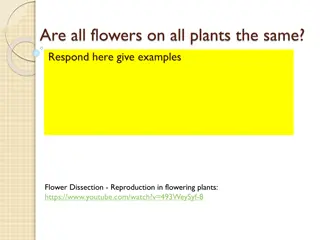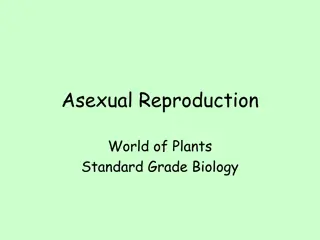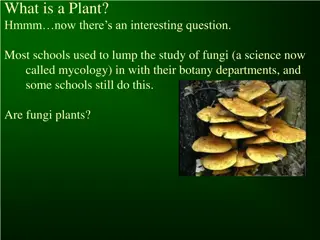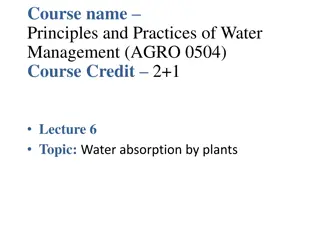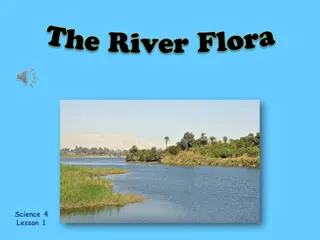TOPIC: DISTRIBUTION OF PLANTS TOPIC: DISTRIBUTION OF PLANTS
There is a wide range of variations in the distribution of vegetation on the globe, influenced by climatic, edaphic, biotic, physical, tectonic, and human factors. Understanding these factors helps in studying the zonal pattern of vegetation and the 6 major floristic kingdoms.
Uploaded on Feb 15, 2025 | 0 Views
Download Presentation

Please find below an Image/Link to download the presentation.
The content on the website is provided AS IS for your information and personal use only. It may not be sold, licensed, or shared on other websites without obtaining consent from the author.If you encounter any issues during the download, it is possible that the publisher has removed the file from their server.
You are allowed to download the files provided on this website for personal or commercial use, subject to the condition that they are used lawfully. All files are the property of their respective owners.
The content on the website is provided AS IS for your information and personal use only. It may not be sold, licensed, or shared on other websites without obtaining consent from the author.
E N D
Presentation Transcript
GOOD MORNING STUDENTS GOOD MORNING STUDENTS BIO BIO GEOGRAPHY GEOGRAPHY TOPIC: DISTRIBUTION OF PLANTS TOPIC: DISTRIBUTION OF PLANTS DAY ORDER: III DAY ORDER: III DATE: 29.08.2020 DATE: 29.08.2020 TIME: 9:30 TO 10:30 TIME: 9:30 TO 10:30 S.NITHYA S.NITHYA LETURER IN GEOGRAPHY LETURER IN GEOGRAPHY GCWK(A) GCWK(A)
Distribution of Plants: 6 Kingdoms Distribution of Plants: 6 Kingdoms There is a wide range of variations in the distri There is a wide range of variations in the distribution of vegetation on the globe. There is a zonal pattern of vegetation vegetation on the globe. There is a zonal pattern of vegetation from equator towards the poles and from seal level to from equator towards the poles and from seal level to vegetation level on the high mountains vegetation level on the high mountains The distribution of plants is affected and controlled by a The distribution of plants is affected and controlled by a variety of factors e.g. variety of factors e.g. ( (i i) Climatic factors (sunlight, temperature, moisture and ) Climatic factors (sunlight, temperature, moisture and humidity, pre humidity, precipitation, soil cipitation, soil- -moisture etc.); moisture etc.); (ii) (ii) Edaphic Edaphic factors (soil nutrients, soil texture, soil structure, factors (soil nutrients, soil texture, soil structure, acidity and alka acidity and alkalinity, nature and properties of soil profiles linity, nature and properties of soil profiles etc.) etc.) (iii) Biotic factors (effects of living organisms mainly animals (iii) Biotic factors (effects of living organisms mainly animals and man of a particular habitat on plants, interactions and man of a particular habitat on plants, interactions between different plant species and between plants and between different plant species and between plants and animals like natural selection, com animals like natural selection, competition, mutualism, paraticism paraticism etc.) etc.) bution of petition, mutualism,
(iv) Physical factors (reliefs and topography, slope angle, gradient and slope aspect, etc.); (v) Tectonic factors (continental displacement and drift, plate movements, endogenetic forces and movements, vulcanicity and seismic events etc.); (vi) Fire factor (forest fire-natural forest fire through lightning, man-induced forest fire- both intentional and accidental; (vii) Dispersion of plants, and (viii) Human interferences.
Distribution of plants may be attempted in a Distribution of plants may be attempted in a variety of ways variety of ways viz viz (i) On the basis of habitats as the distribution of terrestrial and aquatic plants, (ii) On the basis of floral divisions, (iii) On the basis of latitudinal and altitudinal extents, and (iv) On the basis of characteristic features of plant communities etc. The land plant species of the world are The land plant species of the world are grouped into 6 major floristic kingdoms on grouped into 6 major floristic kingdoms on the basis of their worldwide distribution the basis of their worldwide distribution
(1) Australian Kingdom: (1) Australian Kingdom: This floristic kingdom includes the plants of whole Australia which is characterized by typical plant species e.g., eucalyptus. The different species of this unique genera of eucalyptus are so dominant in Australia that they represent 75 percent of all Australian plants. There are over 600 species of eucalyptus which greatly vary as regards their general characteristics as they range from tall, giant and shady eucalyptus trees to dwarf and stunted desert eucalyptus trees. Eucalyptus is said to be related to mimosa which is still found in South America (only a few species).
Eucalyptus has been dispersed and Eucalyptus has been dispersed and distributed by man (deliberately) from distributed by man (deliberately) from Australia to almost every continent. One Australia to almost every continent. One can see extensive plantation of can see extensive plantation of eucalyptus in India particularly along eucalyptus in India particularly along the rail and road sides and it is being the rail and road sides and it is being expanded rapidly by deliberate actions expanded rapidly by deliberate actions of man in all parts of the country of man in all parts of the country irrespective of environmental irrespective of environmental requirements and suitability of this requirements and suitability of this unique exotic plant. The typical endemic unique exotic plant. The typical endemic floras of Australia having floras of Australia having unique characteristics characteristics have developed due to have developed due to its isolation from other continents of the its isolation from other continents of the southern hemisphere because of southern hemisphere because of continental drift. continental drift. unique
(2) Cape Kingdom: (2) Cape Kingdom: The floral kingdom has developed in the southern tip of Africa wherein the plants having bulbs and tubers have developed and these represent the typical plant species of this floral kingdom. The plants of this kingdom belong to the category of cryptophytes which bear buds in the form of bulbs and tubers which are buried in the soils. These bulbs and tubers give birth to other plants as new shoots come out from these bulbs and tubers and are developed as plants.
These plants represent most plants of the gradient such as garden flowering plants (e.g., Loplia, Kniphogia, Erica Freesia etc.). The dispersal of these garden plants became possible when South Africa was colonized by Europeans who distributed these garden flowering plants from South Africa to the gardens of other parts of the world. There is gradual decrease in the number and area of these garden flowering plants in their own native areas (southern part of South Africa) because their areas are continuously being replaced by agricultural lands. The untouched areas still have sclerophyllous shrubs which attain the height of a few meters. There is undergrowth of herbaceous shrubs in the sclerophyllous shrubs.
It may be remembered that the native vegetation of this region before the European colonization consisted of temperate evergreen forests which were extensively cleared off by the Europeans for agricultural proposes and thus the sclerophyllous shrubs developed in this region at later date as secondary succession of vegeta- tion.
(3) Antarctic Kingdom: (3) Antarctic Kingdom: This kingdom includes a narrow strip in the north of Antarctica which runs from Patagonia and southern Chile of South America to New Zealand. The most important representative plant of this zone is Nothofagus which is also known as Southern Beech. About 100 million years ago temperate grasses developed as the native vegetation of this region (New Zealand). The most outstanding and typical species of the grasses were Tussock Grasses though a few spe- cies of Sedges (plants which grow in water) and dicotyledon shrubs were also developed but these original native vegetation have undergone massive modification and transformation since the colonization of New Zealand by the Europeans.
Thus, the present Thus, the present- -day veg Zealand is of modified type which is still Zealand is of modified type which is still characterized by two types of tussock grasses characterized by two types of tussock grasses viz.: viz.: (i) Short Tussock Grasslands have two main species e.g., festuca and poa. The average height of these grass is upto 0.5 m and the colour is yellow-grey, (ii) Tall Tussock Grasslands have the main species of Chiomechloa. Warm temperate areas of New Zealand are characterized by the dominance of the forest of gym-nosperms and angiosperms trees. The main species of the coniferous family of gymnosperms are Podcarpaceae, Cupressaceae and Araucariaceae whereas flowering plants are included in Angiosperms of which Nothofagus is the most important plant. day vegetation of New etation of New
The sub The sub- -tropical forests of New tropical forests of New Zealand are of evergreen type which is Zealand are of evergreen type which is characterized by dense cover of tall characterized by dense cover of tall trees having different vertical strata of trees having different vertical strata of other plants. The original vegetation of other plants. The original vegetation of New Zealand has been greatly modified New Zealand has been greatly modified and destroyed by human activi and destroyed by human activities and the mammals (mainly grazing red the mammals (mainly grazing red deers and rabbits) brought by them from and rabbits) brought by them from Europe. This has led to the Europe. This has led to the destabilization of vegetation destabilization of vegetation community at large scale. community at large scale. ties and deers
(4) (4) Palaeotropical Palaeotropical Kingdom: This kingdom includes most of Africa, South West Asia, South Asia, South East Asia and southern and middle portions of China. This floral kingdom is further divided into 3 This floral kingdom is further divided into 3 sub sub- -kingdoms e.g.: kingdoms e.g.: (i) African sub-kingdom, (ii) Indo-Malaysian sub-kingdom, and (iii) Polynesian sub-kingdom. This floral kingdom is also divided into several floral provinces or region West African rainforest region, Madagascar region, Iran-Turanian region, East Asian region, etc. There is great variation in plant species from one region to another region but few plants are common to all sub- kingdoms and regions. Kingdom:
5) 5) Neotropical Neotropical Kingdom: This region includes the whole of South America except southern Chile and Patagonia. A few genera are common to this kingdom and palaeotropical kingdom mainly Africa because the original flowering plants were developed in South America and Africa during Cretaceous period when all members of Gondwanaland were united together. Later on the spreading of Atlantic sea-floor, disruption of Gondwanaland and westward drift of South America from Africa became responsible for the origin and development of new species at regional level and therefore variations in the plant species of South America and Africa were introduced. Kingdom:
(6) Boreal Kingdom: (6) Boreal Kingdom: This floral kingdom includes the whole of North America except Middle America, Greenland, entire Europe, northern Asia and Arctic region. This is the most extensive kingdom of all the floral kingdoms. This is again divided into several sub- kingdoms and regions or provinces e.g. Rocky Mountainous Region (RMR); Atlantic North American Region Arctic and Sub-Arctic Region (ASAR); Europe-Siberian Region (ESR); Mediterranean Region (MR) etc. Genera and family of plants and major vegetation of the aforesaid floral kingdoms and floral provinces or regions.




